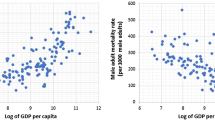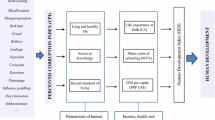Abstract
This paper presents an analysis of the joint, endogenous determination of bureaucratic corruption, economic development and demographic transition. The analysis is based on an overlapping generations model in which reproductive agents mature safely through two periods of life and face a probability of surviving for a third period. This survival probability depends on the provision of public goods and services which may be compromised by corrupt activities on the part of public officials. The dynamic general equilibrium of the economy is characterised by multiple development regimes, transition between which may or may not be feasible. In accordance with empirical evidence, the model predicts that low (high) levels of development are associated with high (low) levels of corruption and low (high) rates of life expectancy.
Similar content being viewed by others
References
Abel A (1985). Precautionary savings and accidental bequests. Am Econ Rev 75: 777–791
Acemoglu D and Verdier T (1998). Property rights, corruption and the allocation of talent: a general equilibrium approach. Econ J 108: 1381–1403
Acemoglu D and Verdier T (2000). The choice between market failures and corruption. Am Econ Rev 90: 194–211
Ades A and Di Tella R (1999). Rents, competition and corruption. Am Econ Rev 89: 982–993
Anand S and Ravallion M (1993). Human development in poor countries: on the role of private incomes and public services. J Econ Perspect 7: 133–150
Azfar O (2001) Corruption and the delivery of health and education services. Working Paper No. 01/01, Centre for Institutional Reform and the Informal Sector. University of Maryland
Azfar O, Gurgur T (2001) Does corruption affect health and education outcomes in the Philippines? Mimeo, Centre for Institutional Reform and the Informal Sector. University of Maryland
Bardhan P (1997). Corruption and development: a review of issues. J Econ Lit 35: 1320–1346
Barro RJ and Sala-i-Martin X (1992). Public finance in models of economic growth. Rev Econ Stud 59: 645–661
Besley T, McLaren J (1993) Taxes and bribery: the role of wage incentives. Econ J 119–141
Bidani B and Ravallion M (1997). Decomposing social indicators using distributional indicators. J Econom 77: 125–139
Blackburn K, Bose N and Haque ME (2006). The incidence and persistence of corruption in economic development. J Econ Dyn Control 30: 2447–2467
Blackburn K and Cipriani GP (1998). Endogenous fertility, mortality and growth. J Popul Econ 11: 517–534
Blackburn K and Cipriani GP (2002). A model of longevity, fertility and growth. J Econ Dyn Control 26: 187–204
Blackburn K, Forgue-Puccio GF (2007) Distribution and development in a model of misgovernance. Eur Econ Rev 51:1534–1563
Bloom DE, Canning D, Sevilla J (2001) Health, human capital and economic growth. Working Paper WG1:8, Commission on Macroeconomics and Health
Chand SK, Moene KO (1999) Controlling fiscal corruption. World Dev 1129–1140
Licandro O and Croix D (1999). Life expectancy and economic growth. Econ Lett 65: 255–263
Diamond J (1989) Government expenditures and economic growth: an empirical investigation. IMF Working Paper No. WP/89/45
Docher A, Herzfeld T (2006) The economic costs of corruption: a survey and new evidence. Working Paper, University of Konstanz
Easterlin RA (1996). Growth triumphant. University of Michigan Press, Ann Arbor
Ehrilich I and Lui FT (1991). Intergenerational trade, longevity and economic growth. J Polit Econ 99: 1029–1060
Ehrlich I and Lui FT (1997). The problem of population and growth: a review of the literature from Malthus to contemporary models of endogenous population and endogenous growth. J Econ Dyn Control 21: 205–242
Ehrlich I and Lui FT (1999). Bureaucratic corruption and endogenous economic growth. J Polit Econ 107: 270–293
Fisman R and Gatti R (2002). Decentralisation and corruption: evidence across countries. J Public Econ 83: 325–345
Fogel RW (1994). Economic growth, population theory and physiology: the bearing of long-term processes on the making of economic policy. Am Econ Rev 84: 369–395
Fogel RW (1997). New findings on secular trends in nutrition and mortality: some implications for population theory. In: Rosenzweig, M and Stark, O (eds) Handbook of population and family economics, pp. Elsevier, Amserdam
Gould DJ, Amaro-Reyes JA (1983) The effects of corruption on administrative performance. World Bank Staff Working Paper No. 580
Gupta S, Davoodi H, Tiongson E (2000) Corruption and the provision of health care and education services. IMF Working Paper No. 00/116
Gupta S, Verhoeven M, Tiongson E (2001) Public spending on health care and the poor. Working Paper 01/127, International Monetary Fund
Gyimah-Brempong K (2002). Corruption, economic growth and income inequality in Africa. Econ Gov 3: 183–209
Gyimah-Brempong K and Wilson M (2004). Health human capital and economic growth in sub-Sahara African and OECD countries. Q Rev Econ Finance 44: 296–320
Huther J, Shah A (2000) Anti-corruption policies and programmes: a framework for evaluation. World Bank Policy Research Working Paper No. 2501
Jain AK (2001). Corruption: a review. J Econ Surv 15: 71–121
Jones CI (2001) Was an industrial revolution inevitable? Economic growth over the very long-run. Adv Macroecon 1(2) (article 1)
Kalemli-Ozcan S (2002). Does mortality decline promote economic growth. J Econ Growth 7: 411–439
Kalemli-Ozcan S, Ryder H and Weil D (2000). Mortality decline, human capital investment and economic growth. J Dev Econ 62: 1–23
Kannisto V, Lauritsen J, Thatcher AR and Vaupel J (1994). Reductions in mortality at advanced ages: several decades of evidence from 27 countries. Popul Dev Rev 20: 793–810
Kaufmann D, Kraay A, Zoido-Labaton P (1999) Governance matters. Policy Research Working Paper No.2196, Development Research Group, World Bank
Keefer P and Knack S (1997). Why don’t poor countries catch up? A cross-national test of an institutional explanation. Econ Inq 35: 590–602
Kirk D (1996). Demographic transition theory. Popul Stud 50: 361–387
Klitgaard R (1988). Controlling corruption. University of California Press, Berkeley
Knowles S and Owen PD (1995). Health capital and cross-country variations in per capita income in the Mankiw–Romer–Weil model. Econ Lett 48: 99–106
Lee RD and Tuljapurkar S (1997). Death and taxes: how longer life will affect social security. Demography 34: 67–82
Lewis M (2006) Governance and corruption in public health care systems. Working Paper No.78, Centre for Global Development
Li H, Xu LC and Zou H (2000). Corruption, income distribution and growth. Econ Polit 12: 155–182
Lichtenberg FR (1998) Pharmaceutical innovation, mortality reduction and economic growth. NBER Working Paper No. 6569
Livi-Bacci M (1997). A concise history of World population. Blackwell, Malden
Mauro P (1995). Corruption and growth. Q J Econ 110: 681–712
Mauro P (1997). The effects of corruption on growth, invsetment and government expenditure: a cross-country analysis. In: Elliott, KA (eds) Corruption and the global economy, pp. Institute for International Economics, Washington DC
McKeown T, Bower RC and Record G (1972). An interpretation of the modern rise of population in Europe. Popul Stud 26: 45–82
Mirowsky J and Ross CE (1998). Education, personal control, lifestyle and health—a human capital hypothesis. Res Ageing 20: 415–449
Mookherjee D (1997) Incentive reforms in developing country bureaucracies: lessons from tax administration. Paper presented at the Annual World Bank Conference on Development Economics, Washington DC
Otani I and Villanueva D (1990). Long term growth in developing countries and its determinants: an empirical analysis. World Dev 18: 769–783
Paldam M (2002). The big pattern of corruption, economics, culture and seesaw dynamics. Eur J Polit Econ 18: 215–240
Preston SH (1978). The changing relation between mortality and economic development. Popul Stud 29: 231–248
Preston SH (1980). Mortality decline in less developed countries. In: Easterlin, R (eds) Population and economic change in developing countries, pp. Chicago University Press, Chicago
Pritchett L and Summers L (1996). Wealthier is healthier. J Hum Resour 31: 844–868
Rajkumar A, Sunil A and Swaroop V (2001). Public spending and outcomes: does governance matter. World Bank, Mimeo
Rauch JE and Evans PB (2000). Bureaucratic structure and bureaucratic performance in less developed countries. J Public Econ 76: 49–71
Rijckeghem CV, Weder B (1997) Corruption and the rate of temptation: do low wages in the civil service cause corruption. IMF Working Paper No.WP/97/73
Rose-Ackerman S (1999). Corruption and government: causes, consequences and reform. Cambridge University Press, Cambridge
Sah RK (1988) Persistence and pervasiveness of corruption: new perspectives. Yale Economic Growth Research Centre Discussion Paper No.560.48
Sarte P-D (2000). Informality and rent-seeking bureaucracies in a model of long-run growth. J Monet Econ 46: 173–197
Schofield R, Reher D and Bideau A (1991). The decline of mortality in Europe. Oxford University Press, Oxford
Sen AK (1999). Development as freedom. Oxford University Press, Oxford
Shleifer A and Vishny R (1993). Corruption. Q J Econ 10: 599–617
Strauss J and Thomas D (1998). Health, nutrition and economic development. J Econ Lit 36: 766–817
Tamura R (2003). Human capital and economic development. Clemson University, Mimeo
Tanzi V (1998) Corruption around the world: causes, scope and cures. IMF Working Paper No.WP/98/63
Tanzi V, Davoodi H (1997) Corruption, public investment and growth. IMF Working Paper No.WP/97/139
Treisman D (2000). The causes of corruption: a cross-national study. J Public Econ 76: 399–457
Wagstaff A and Claeson A (2005). Rising to the Challenges: the Millenium Development Goals for Health. World Bank, Washington DC
Zhang J and Zhang J (2001). Longevity and economic growth in a dynastic family model with an annuity market. Econ Lett 72: 269–277
Zhang J, Zhang J and Lee R (2001). Mortality decline and long-run economic growth. J Public Econ 80: 485–507
Author information
Authors and Affiliations
Corresponding author
Additional information
The authors are grateful for the comments of two anonymous referees on an earlier version of the paper. The usual disclaimer applies.
Rights and permissions
About this article
Cite this article
Blackburn, K., Sarmah, R. Corruption, development and demography. Econ Gov 9, 341–362 (2008). https://doi.org/10.1007/s10101-007-0045-0
Received:
Accepted:
Published:
Issue Date:
DOI: https://doi.org/10.1007/s10101-007-0045-0




